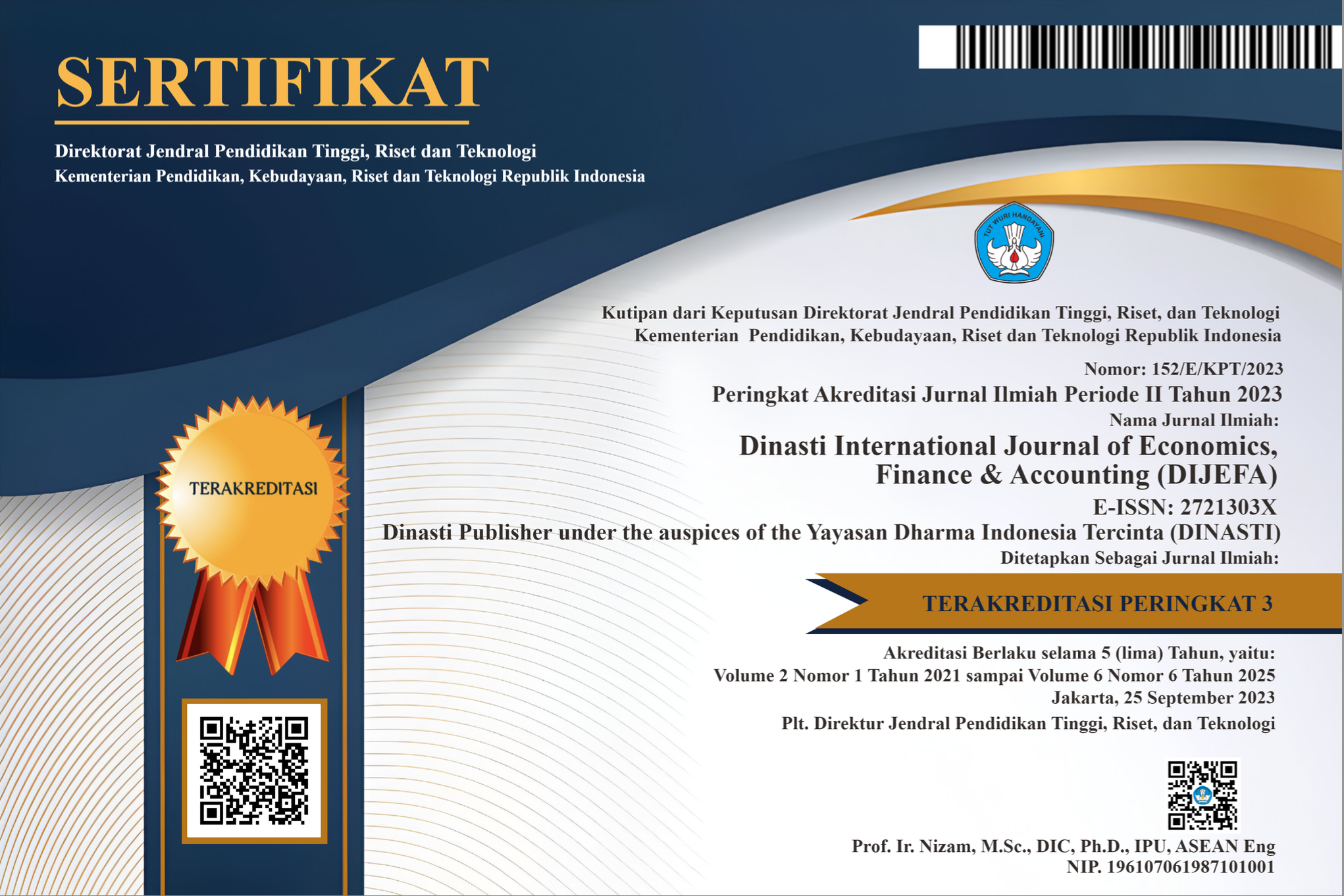Intelligent Banking Chatbot: Intention to Continue Through Millennial Customer Satisfaction in Indonesia Using the TAM Method
DOI:
https://doi.org/10.38035/dijefa.v4i6.2277Keywords:
Perceived Usefulness, Perceived Ease of Use, Service Quality, Intention to Continue Using ChatbotAbstract
This study examines the impact of perceived usefulness and ease of use on the intention to continue utilizing banking chatbots in Indonesia. The sample comprises Generation Millennials enrolled in Master's degree programs in Tangerang Raya, Banten Province. These individuals have utilized the banking chatbots MITA, VIRA, AISYAH, CINTA, and SABRINA. The sample comprised 230 individuals, and the sampling method employed was simple random sampling. Data collection employs a survey methodology with a questionnaire instrument. The data underwent processing utilizing path analysis techniques facilitated by SPSS Version 26 software. The study yielded findings indicating that both partial and simultaneous judgment of usefulness and ease of use had a favorable and substantial impact on customer satisfaction and intention to continue. Customer satisfaction was discovered to impact the level of ongoing interest. Similarly, the ongoing attraction of millennials towards utilizing banking chatbots in Indonesia is driven by their perception of the chatbots' usefulness and ease of use, with customer satisfaction as a mediating factor. The coefficient of determination for customer satisfaction is 74.4%, while the coefficient of determination for intention to continue using chatbots is 83.2%.
References
Chatbot Perbankan Terbaik. (2020, September). Marketing Research Indonesia. https://www.facebook.com/mriresearchindonesia/posts/3-chatbot-perbankan-terbaik-di-indonesiachatbot-merupakan-layanan-yang-menawarka/3217932118285697/
Alalwan, A. A., Dwivedi, Y. K., Rana, N. P., & Algharabat, R. (2018). Examining factors influencing Jordanian customers’ intentions and adoption of internet banking: Extending UTAUT2 with risk. Journal of Retailing and Consumer Services, 40(July 2017), 125–138. https://doi.org/10.1016/j.jretconser.2017.08.026
Ali, H., Lilik, P., Nugroho, H., Halim, T., Firdaus, K., & Huda, N. (2020). Indonesia Gen Z And Millenial Report 2020: The Battle Of Our Generation. PT Alvara Strategi Indonesia, 134.
Amin, M. K., Azhar, A., Amin, A., & Akter, A. (2016). Applying the technology acceptance model in examining Bangladeshi consumers’ behavioral intention to use mobile wallet: PLS-SEM approach. 2015 18th International Conference on Computer and Information Technology, ICCIT 2015, 93–98. https://doi.org/10.1109/ICCITechn.2015.7488049
Amoroso, D., & Lim, R. (2017). The mediating effects of habit on continuance intention. International Journal of Information Management, 37(6), 693–702. https://doi.org/10.1016/j.ijinfomgt.2017.05.003
Ariani, M. (2022). Analisis Intention To Use Mobile Banking Pada Bank Mayora. Journal of Economics Development Issues, 5(2), 86–96. https://doi.org/10.33005/jedi.v5i2.125
Arikunto, S. (2019). Prosedur Penelitian Suatu Pendekatan Praktik. Rineka Cipta.
Ashfaq, M., Yun, J., Yu, S., & Loureiro, S. M. C. (2020). I, Chatbot: Modeling the determinants of users’ satisfaction and continuance intention of AI-powered service agents. Telematics and Informatics, 54, 101473. https://doi.org/10.1016/j.tele.2020.101473
Aslam, W., Ahmed Siddiqui, D., Arif, I., & Farhat, K. (2023). Chatbots in the frontline: drivers of acceptance. Kybernetes, 52(9), 3781–3810. https://doi.org/10.1108/K-11-2021-1119/FULL/XML
Bagana, B. D., Irsad, M., & Santoso, I. H. (2021). Artificial Intelligence As a Human Substitution? Customer’S Perception of the Conversational User Interface in Banking Industry Based on Utaut Concept. Review of Management and Entrepreneurship, 5(1), 33–44. https://doi.org/10.37715/rme.v5i1.1632
Bhattacherjee, A. (2001a). Understanding Information Systems Continuance: An Expectation-Confirmation Model. MIS Q., 25, 351–370. https://doi.org/10.2307/3250921
Bhattacherjee, A. (2001b). Understanding Information Systems Continuance: An Expectation-Confirmation Model. MIS Quarterly, 25(3), 351–370.
Brill, T. M., Munoz, L., & Miller, R. J. (2019). Siri, Alexa, and other digital assistants: a study of customer satisfaction with artificial intelligence applications. Journal of Marketing Management, 35(15–16), 1401–1436. https://doi.org/10.1080/0267257X.2019.1687571
Calvaresi, D., Ibrahim, A., Calbimonte, J. P., Fragniere, E., Schegg, R., & Schumacher, M. I. (2023). Leveraging inter-tourists interactions via chatbots to bridge academia, tourism industries and future societies. Journal of Tourism Futures, 9(3), 311–337. https://doi.org/10.1108/JTF-01-2021-0009
Capgemini.com. (2019). Smart Talk: How organizations and consumers are embracing voice and chat assistants. Www.Capgemini.Com. https://www.capgemini.com/news/press-releases/smart-talk-how-organizations-and-consumers-are-embracing-voice-and-chat-assistants/
Cardona, D. R., Janssen, A., Guhr, N., Breitner, M. H., & Milde, J. (2021). A matter of trust? Examination of chatbot usage in insurance business. Proceedings of the Annual Hawaii International Conference on System Sciences, 2020-Janua, 556–565. https://doi.org/10.24251/hicss.2021.068
Ceccarini, C., & Prandi, C. (2019). Tourism for all: A mobile application to assist visually impaired users in enjoying tourist services. 2019 16th IEEE Annual Consumer Communications and Networking Conference, CCNC 2019. https://doi.org/10.1109/CCNC.2019.8651848
Clark, S. (2020). 5 Ways Chatbots Improve Employee Experience. https://www.reworked.co/employee-experience/5-ways-chatbots-improve-employee-experience/
Darmawan, S., & Setyorini, R. (2020). Analisa Faktor-Faktor Adopsi Chatbot Line Smb Telkom Dengan Pendekatan Technology Acceptance Model Yang Dimodifikasi. ProBank, 5(2), 241–254. https://doi.org/10.36587/probank.v5i2.729
Davis, F. D. (1989a). Perceived usefulness, perceived ease of use, and user acceptance of information technology. MIS Quarterly: Management Information Systems, 13(3), 319–339. https://doi.org/10.2307/249008
Davis, F. D. (1989b). Perceived Usefulness, Perceived Ease of Use, and User Acceptance of Information Technology. MIS Q., 13, 319–340. https://doi.org/10.2307/249008
Davis, F. D., Bagozzi, R. P., & Warshaw, P. R. (1989). User Acceptance of Computer Technology: A Comparison of Two Theoretical Models. Management Science, 35(8), 982–1003. https://doi.org/10.1287/mnsc.35.8.982
Davis, F. D., Bagozzi, R., & Warshaw, P. R. (1992). Extrinsic and Intrinsic Motivation to Use Computers in the Workplace. Management Science, 35, 982–1003. https://doi.org/10.1287/MNSC.35.8.982
Duy Phuong, N. N., Luan, L. T., Van Dong, V., & Le Nhat Khanh, N. (2020). Examining customers’ continuance intentions towards e-wallet usage: The emergence of mobile payment acceptance in Vietnam. Journal of Asian Finance, Economics and Business, 7(9), 505–516. https://doi.org/10.13106/JAFEB.2020.VOL7.NO9.505
Eren, B. A. (2021). Determinants of customer satisfaction in chatbot use: evidence from a banking application in Turkey. International Journal of Bank Marketing, 39(2), 294–311. https://doi.org/10.1108/IJBM-02-2020-0056
Farah, M. F., Hasni, M. J. S., & Abbas, A. K. (2018). Mobile-banking adoption: empirical evidence from the banking sector in Pakistan. International Journal of Bank Marketing, 36(7), 1386–1413. https://doi.org/10.1108/IJBM-10-2017-0215
Fishbein, M., & Ajzen, I. (1977). Belief, Attitude, Intention, and Behavior: An Introduction to Theory and Research. Contemporary Sociology, 6, 244. https://doi.org/10.2307/2065853
Fokina, M. (2024). The Future of Chatbots: 80+ Chatbot Statistics for 2024. https://www.tidio.com/blog/chatbot-statistics/
Følstad, A., Nordheim, C. B., & Bjørkli, C. A. (2018). What makes users trust a chatbot for customer service? An exploratory interview study. Lecture Notes in Computer Science (Including Subseries Lecture Notes in Artificial Intelligence and Lecture Notes in Bioinformatics), 11193 LNCS, 194–208. https://doi.org/10.1007/978-3-030-01437-7_16/COVER
Ghozali I. (2013). Aplikasi Analisis Multivariate Dengan Program SPSS. Badan Penerbit Universitas Dipenogoro.
Giovanis, A., Athanasopoulou, P., Assimakopoulos, C., & Sarmaniotis, C. (2019). Adoption of mobile banking services: A comparative analysis of four competing theoretical models. International Journal of Bank Marketing, 37(5), 1165–1189. https://doi.org/10.1108/IJBM-08-2018-0200
Goot, M., Hafkamp, L., & Dankfort, Z. (2020). UvA-DARE (Digital Academic Repository) Customer service chatbots: A qualitative interview study into customers’ communication journey. https://doi.org/10.1007/978-3-030-68288-0
Gümü?, N., & Çark, Ö. (2021). The Effect of Customers’ Attitudes Towards Chatbots on their Experience and Behavioural Intention in Turkey. Interdisciplinary Description of Complex Systems, 19(3), 420–436. https://doi.org/10.7906/indecs.19.3.6
Hamid, A. A., Razak, F. Z. A., Bakar, A. A., & Abdullah, W. S. W. (2016). The Effects of Perceived Usefulness and Perceived Ease of Use on Continuance Intention to Use E-Government. Procedia Economics and Finance, 35(October 2015), 644–649. https://doi.org/10.1016/s2212-5671(16)00079-4
Hapsoro, B. B., & Kismiatun. (2022). The Effect of Perceived Ease of Use, Perceived Usefulness, and Perceived Security on E-Wallet Continuance Intention of Shopeepay Through E-Satisfaction. Management Analysis Journal, 12(4), 395–405.
Ho, Y.-H., Alam, S. S., Masukujjaman, M., Lin, C.-Y., Susmit, S., & Susmit, S. (2022). Intention to Adopt AI-Powered Online Service Among Tourism and Hospitality Companies. International Journal of Technology and Human Interaction, 18(1), 1–19. https://doi.org/10.4018/ijthi.299357
Hosseini, M. H., Fatemifar, A., & Rahimzadeh, M. (2015). Effective Factors of the Adoption of Mobile Banking Services by Customers. Kuwait Chapter of Arabian Journal of Business and Management Review, 4(6), 1–13. https://doi.org/10.12816/0018964
Huang, D.-H., & Chueh, H.-E. (2021). Chatbot usage intention analysis: Veterinary consultation. Journal of Innovation & Knowledge, 6(3), 135–144. https://doi.org/10.1016/j.jik.2020.09.002
Igbaria, M., Guimaraes, T., & Davis, G. B. (1995). Testing the Determinants of Microcomputer Usage via a Structural Equation Model. Journal of Management Information Systems, 11(4), 87–114. https://doi.org/10.1080/07421222.1995.11518061
Kasilingam, D. L. (2020). Understanding the attitude and intention to use smartphone chatbots for shopping. Technology in Society, 62, 101280. https://doi.org/10.1016/j.techsoc.2020.101280
Kim, B. (2019). Understanding Key Antecedents of Consumer Loyalty toward Sharing-Economy Platforms: The Case of Airbnb. https://doi.org/10.3390/su11195195
Kwangsawad, A., & Jattamart, A. (2022). Overcoming customer innovation resistance to the sustainable adoption of chatbot services: A community-enterprise perspective in Thailand. Journal of Innovation and Knowledge, 7(3), 100211. https://doi.org/10.1016/j.jik.2022.100211
Ledignan, S. M. D. R. D. (2020). Smart money. In Capgemini Research Institute. https://www.capgemini.com/wp-content/uploads/2020/11/Report-AI-in-CX-FS.pdf
Martins, C., Oliveira, T., & Popovi?, A. (2014). Understanding the Internet banking adoption: A unified theory of acceptance and use of technology and perceived risk application. Int. J. Inf. Manag., 34, 1–13. https://doi.org/10.1016/j.ijinfomgt.2013.06.002
Mawhinney, C. H., & Lederer, A. L. (1990). A study of personal computer utilization by managers. Information and Management, 18(5), 243–253. https://doi.org/10.1016/0378-7206(90)90026-E
Ngubelanga, A., & Duffett, R. (2021). Modeling mobile commerce applications’ antecedents of customer satisfaction among millennials: An extended tam perspective. Sustainability (Switzerland), 13(11). https://doi.org/10.3390/su13115973
Nguyen, D. M., Chiu, Y. T. H., & Le, H. D. (2021). Determinants of continuance intention towards banks’ chatbot services in Vietnam: A necessity for sustainable development. Sustainability (Switzerland), 13(14), 1–24. https://doi.org/10.3390/su13147625
Olivia, M., & Marchyta, N. K. (2022). The Influence of Perceived Ease of Use and Perceived Usefulness on E-Wallet Continuance Intention. Jurnal Teknik Industri, 24(1), 13–22. https://doi.org/10.9744/jti.24.1.13-22
Pereira, T., Limberger, D. P. F., & Ardigó, D. C. M. (2021). The moderating effect of the need for interaction with a service employee on purchase intention in chatbots. Telematics and Informatics Reports, 1–4(June 2021), 100003. https://doi.org/10.1016/j.teler.2022.100003
Pillai, R., & Sivathanu, B. (2020). Adoption of AI-based chatbots for hospitality and tourism. International Journal of Contemporary Hospitality Management, 32(10), 3199–3226. https://doi.org/10.1108/IJCHM-04-2020-0259/FULL/XML
Przegalinska, A., Ciechanowski, L., Stroz, A., Gloor, P., & Mazurek, G. (2019). In bot we trust: A new methodology of chatbot performance measures. Business Horizons, 62(6), 785–797. https://doi.org/10.1016/j.bushor.2019.08.005
Richad, R., Vivensius, V., Sfenrianto, S., & Kaburuan, E. R. (2019). Analysis of factors influencing millennial’s technology acceptance of chatbot in the banking industry in Indonesia. International Journal of Management, 10(3), 107–118. https://doi.org/10.34218/IJM.10.3.2019.011
Roadmap Pengembangan Perbankan Indonesia 2020 - 2025. (2021). Otoritas Jasa Keuangan. https://www.ojk.go.id/id/berita-dan-kegiatan/info-terkini/Pages/-Roadmap-Pengembangan-Perbankan-Indonesia-2020---2025.aspx
Roca, J. C., Chiu, C. M., & Martínez, F. J. (2006). Understanding e-learning continuance intention: An extension of the Technology Acceptance Model. International Journal of Human Computer Studies, 64(8), 683–696. https://doi.org/10.1016/j.ijhcs.2006.01.003
Rosdakarya, D. (2013). Metode Penelitian Kuantitatif. Remaja Rosdakarya.
Sachan, A., Kumar, R., & Kumar, R. (2018). Examining the impact of e-government service process on user satisfaction. Journal of Global Operations and Strategic Sourcing, 11(3), 321–336. https://doi.org/10.1108/JGOSS-11-2017-0048
Sands, S., Ferraro, C., Campbell, C., & Tsao, H. Y. (2021). Managing the human–chatbot divide: how service scripts influence service experience. Journal of Service Management, 32(2), 246–264. https://doi.org/10.1108/JOSM-06-2019-0203/FULL/XML
Sarbabidya, S., & Saha, T. (2020). Role of Chatbot in Customer Service: A Study from the Perspectives of the Banking Industry of Bangladesh. International Review of Business Research Papers, 16(1), 231–248. https://zantworldpress.com/wp-content/uploads/2020/03/13.-601-Tama-Saha.pdf
Selamat, M. A., & Windasari, N. A. (2021). Chatbot for SMEs: Integrating customer and business owner perspectives. Technology in Society, 66(January), 101685. https://doi.org/10.1016/j.techsoc.2021.101685
Shang, D., & Wu, W. (2017). Understanding mobile shopping consumers’ continuance intention. Industrial Management and Data Systems, 117(1), 213–227. https://doi.org/10.1108/IMDS-02-2016-0052
Shao, Z., & Yin, H. (2019). Building customers’ trust in the ridesharing platform with institutional mechanisms: An empirical study in China. Internet Research, 29(5), 1040–1063. https://doi.org/10.1108/INTR-02-2018-0086
Sheehan, B., Jin, H. S., & Gottlieb, U. (2020). Customer service chatbots: Anthropomorphism and adoption. Journal of Business Research, 115, 14–24. https://doi.org/10.1016/J.JBUSRES.2020.04.030
Sladden, C. O. (2022). Chatbots’ failure to satisfy customers is harming businesses, says study - Verdict. https://www.verdict.co.uk/chatbots-failure-to-satisfy-customers-is-harming-businesses-says-study/
Statistik Chatbot 2021: Pasar dan Peluang. (2022). Widya Wicara. https://widyawicara.com/article/read/statistik-chatbot-2021-pasar-dan-peluang/
Suchánek, P., & Králová, M. (2019). Customer satisfaction, loyalty, knowledge and competitiveness in the food industry. Economic Research-Ekonomska Istrazivanja , 32(1), 1237–1255. https://doi.org/10.1080/1331677X.2019.1627893
Sugiyono. (2012). Metode Penelitian Kuantitatif Kualitatif dan R&B. Alfabeta.
Tom Dieck, M. C., & Jung, T. (2018). A theoretical model of mobile augmented reality acceptance in urban heritage tourism. Current Issues in Tourism, 21(2), 154–174. https://doi.org/10.1080/13683500.2015.1070801
Venkatesh, V., & Davis, F. D. (1996). A model of the antecedents of perceived ease of use: Development and test. Decision Sciences, 27(3), 451–481. https://doi.org/10.1111/j.1540-5915.1996.tb00860.x
Venkatesh, V., & Davis, F. D. (2000). Theoretical extension of the Technology Acceptance Model: Four longitudinal field studies. Management Science, 46(2), 186–204. https://doi.org/10.1287/mnsc.46.2.186.11926
Wilson, N., & Christella, R. (2019). An Empirical Research of Factors Affecting Customer Satisfaction: A Case of the Indonesian E-Commerce Industry. DeReMa (Development Research of Management): Jurnal Manajemen, 14(1), 21. https://doi.org/10.19166/derema.v14i1.1108
Zhang, J., She, L., Wang, D., & Shafiq, A. (2022). Chinese Consumers’ E-Learning Satisfaction and Continuance Purchase Intention on Paid Online Python Course. Frontiers in Psychology | Www.Frontiersin.Org, 1, 849627. https://doi.org/10.3389/fpsyg.2022.849627
Zhang, W., Zhang, W., Wang, C., & Daim, T. U. (2021). What drives continuance intention of disruptive technological innovation? The case of e-business microcredit in China. Technology Analysis and Strategic Management, 34(8), 905–918. https://doi.org/10.1080/09537325.2021.1932798
Zhao, L., Lu, Y., Zhang, L., & Chau, P. Y. K. (2012). Assessing the effects of service quality and justice on customer satisfaction and the continuance intention of mobile value-added services: An empirical test of a multidimensional model. Decision Support Systems, 52(3), 645–656. https://doi.org/10.1016/j.dss.2011.10.022
Downloads
Published
How to Cite
Issue
Section
License
Copyright (c) 2024 Humairoh Humairoh, Nandan Limakrisna, Anoesyirwan Moeins

This work is licensed under a Creative Commons Attribution 4.0 International License.
Authors who publish their manuscripts in this journal agree to the following conditions:
- The copyright on each article belongs to the author(s).
- The author acknowledges that the Dinasti International Journal of Economics, Finance & Accounting (DIJEFA) has the right to be the first to publish with a Creative Commons Attribution 4.0 International license (Attribution 4.0 International (CC BY 4.0).
- Authors can submit articles separately, arrange for the non-exclusive distribution of manuscripts that have been published in this journal into other versions (e.g., sent to the author's institutional repository, publication into books, etc.), by acknowledging that the manuscript has been published for the first time in the Dinasti International Journal of Economics, Finance & Accounting (DIJEFA).


























































